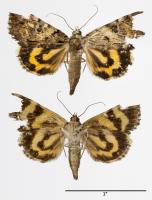Taxonomy
Superfamily:
Family: Subfamily: Tribe: P3 Number: MONA Number:
Comments: One of 103 species in this genus that occur in North America (Lafontaine and Schmidt, 2010, 2015), 67 of which have been recorded in North Carolina. As redefined by Kons and Borth (2015b), aestivlia belongs to a Rosaceae-feeding group that was originally defined by Barnes and McDunnough (1918) as their Group XVII (also adopted by Forbes, 1954). Twelve other members of this group also occur in North Carolina.
Species Status: Genetic barcoding, along with morphological differences, shows that this species is distinct from other members of what Kons and Borth (2015b) identify as a "southern crataegi complex". North Carolina specimens collected in the Roanoke River floodplain in 1996 were originally identified by L. Gall as possibly representing a southern form of blandula. However, Gall, Kons, and Borth recently determined (2/2/2018, pers. comm. to S. Hall) that at least one specimen probably represents aestivalia, which had previously only been confirmed from Florida. That determination, however, was based on a photograph and dissection and/or barcoding needs to be done to completely confirm the identity of the North Carolina specimens.
Identification
Adult Markings: A medium-sized Underwing, with mottled gray, white, and brown forewings and yellow- and black-banded hindwings. The forewing pattern is highly variable, with both melanic and pale forms occurring in addition to the typical form. The normal pattern is similar to several other Crataegus-feeding members of this species group, particularly C. crataegi and blandula, and especially to a southern clade of crataegi identified based on barcoding by Kons and Borth (2015b). As in other members of this group, there is a black basal dash; the basal area is usually darkened; the median area is paler, with a whitish ring around the reniform; the postmedian is usually followed by a brown shade. However, the basal area is usually less intensely black as in crataegi, blandula, and pretiosa and usually lacks the black band along the inner margin between the antemedian and postmedian lines. The median area is usually not as pale as in pretiosa and the pale band around the reniform is not as bright white. Compared to mira -- another member of this group that co-occurs with aestivalia along the lower Roanoke -- the brown shade beyond the postmedian is not as rich and the pale bands on the hindwing are not as orange and the black bands not as wide. Currently, we do not have records for crataegi or blandula from the Coastal Plain, but there is at least a possibility that representatives of the southern clade of crataegi could be discovered in this area. Until that form is definitely shown to occur here -- requiring barcoding or detailed dissections -- crataegi-like specimens captured in our Coastal Plain will be presumed to represent aestivalia.
Forewing Length: 16 to 21 mm, males; 17 to 22 mm females (Kons and Borth, 2015b)
Adult Structural Features: The male and female reproductive structures are thoroughly described and illustrated by Kons and Borth (2015b). The most diagnostic features, however, are the shapes and sizes of the diverticula of the male vesica, which can only be seen when the vesica is everted and carefully prepared (see Kons and Borth for details).
Adult ID Requirements: Identifiable from photos showing hindwings, abdomen, or other specialized views [e.g., frons, palps, antennae, undersides].
Immatures and Development: Photographs of an egg and larvae are given in Kons and Borth (2015b). Features of the eggs are also described but no details are given concerning the larvae.

 »
»

 »
»